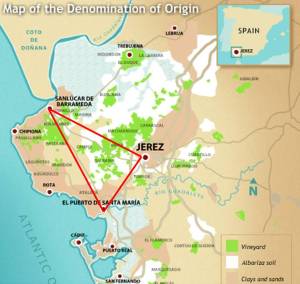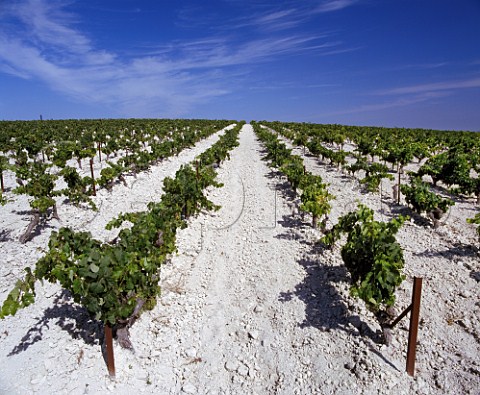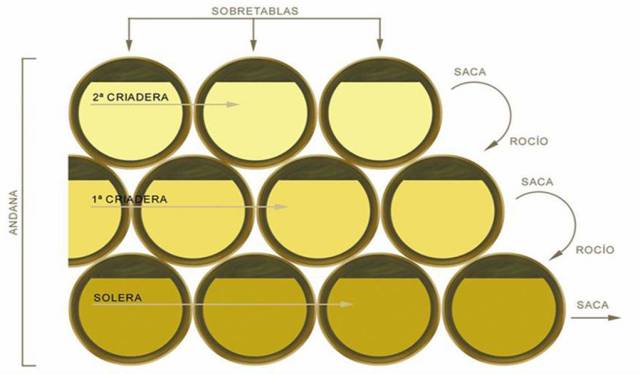"If penicillin can cure those that are ill, Spanish sherry can bring the dead back to life." - Sir Alexander Fleming
"So fine, varied and noble a wine is sherry - and so intriguingly complicated is it to make..." - Jancis Robinson
Sherry is a fascinating wine with a rich and colorful
history. Luckily for us the Sherry wine styles haven’t changed much over their
3,000 years of production, allowing us the opportunity to explore an ancient
wine untouched by modernization.
 |
| the Sherry triangle |
The “Sherry triangle” consists of three cities in the
southwest of Spain: Jerez de la Frontera (from which Sherry derives its name),
Sanlúcar
de Barrameda, and El Puerto de Santa María. This area has been making wine
since a Canaanite tribe, the Phoenicians, brought grapes here from the Ancient
Middle East in 1100 BC. Later the Moors introduced alembic distillation to the
region, creating a precursor to brandy. Spanish
and Portuguese explorers during the Age of Exploration loaded up their ships
with Sherry in order to have the comfort of wine while traveling far from home.
Sherry was likely the first wine that
came to the New World aboard explorers’ ships. The English love for “Sherris
sack” (literally translated from “Jerez saca” as “extracted wine from Jerez”)
began with Sir Francis Drake’s raid on the Spanish Armada in Cadiz during which
he captured many barrels of the coveted wine and brought them home; William
Shakespeare’s Sir John Falstaff has been famously quoted as saying “If I had a thousand sons, the first humane
principle I would teach them should be, to forswear thin potations and to
addict themselves to sack.”
Sherry clearly has
quite a history. This story would never have come about, however, were it not
for the unique soil in the Sherry triangle and the two crucial winds that blow
across it.
 |
| Palomino vines in albariza |
Now for the
winemaking. After the grapes are harvested and fermented, the desired Sherry
style is determined. If the wine is destined to become a crisp, pale Fino (or
Manzanilla, which is a very light Fino made only in Sanlúcar de Barrameda),
brandy is added to raise the alcohol level to around 15%. If it is made in the
Oloroso or Amontillado style, alcohol is added until the wine reaches 18%. This
very important distinction determines the style of the Sherry.
 |
| a Sherry cask with flor |
Finos have a low
enough alcohol content such that a special native yeast that forms a film known as flor can
survive in it and grow into a protective layer on top of the wine. Finos then
begin aging “biologically” as tiny amounts of oxygen seep through the layer and
the yeasts in the film slowly convert the acid and sugar in the wine. Biological
aging increases acetaldehydes in the wine, producing the characteristic bite
Fino is known to have.
 |
| an Oloroso, Amontillado, and Fino, left to right |
Amontillados and
Olorosos have too high an alcohol content to support the film of flor
for long. The layer dissipates, leaving the wine exposed to oxygen. This
darkens the color and gives a nutty flavor to these Sherries. Palo Cortados are
a very interesting hybrid of the two styles which originally start off as Finos
until the flor dies off (intentionally or accidentally), after which
oxidative aging occurs. These wines have the bite and salinity of Finos and the
complex nuttiness of Olorosos.
Sherry wines are
aged in a complex system called a solera. This is a process of
fractional blending which mixes wines from each new vintage with wines from all
previous vintages. The aging process is sped up by blending; Sherry derives its
unique style partially from this process.
 |
| a drawing of a solera system |
Sherry is often misunderstood in the international wine market. This is largely due to the many imposters, including that bottle labeled "Sherry" you can find in the supermarket... that bottle, in fact, typically does not even contain wine. It often is a mix of distilled cheap alcohol and artificial coloring. Also, the many confusing styles of Sherry are intimidating to would-be consumers. But hopefully a little clarification of Sherry will pique interest in this ancient wine.
If you’d like to have a taste of these delicious wines, sample a few with a flight (our Sherry flight can be seen on our menu at The Barrel Room here) and delve into the traditional and generally unappreciated world of Sherry!
If you’d like to have a taste of these delicious wines, sample a few with a flight (our Sherry flight can be seen on our menu at The Barrel Room here) and delve into the traditional and generally unappreciated world of Sherry!
- - Sarah
I am reaching out regarding permissions to use an image credited to you, and I have listed the relevant information below:
ReplyDeleteI am currently working with Top Hat to publish an online Introduction to Beverages textbook to use with my classes at Texas Tech University. While researching, I came across the following image that listed you as the photo source:
http://eatsdrinksandsleeps.files.wordpress.com/2011/05/the-sherry-triangle.jpg?w=300&h=284
I am looking to include it as a supporting image in a 'Dessert Wine' chapter, and I believe it would provide valuable insight into dessert wines. As this is a commercial project, I would like your permission to include the above image within my work. It would be cited with proper attributions, and if there are any specific instructions with how you would prefer to be credited please let me know.
Very Appreciatively,
Trey Blankenship
Assistant Director, Texas Wine Marketing Research Institute